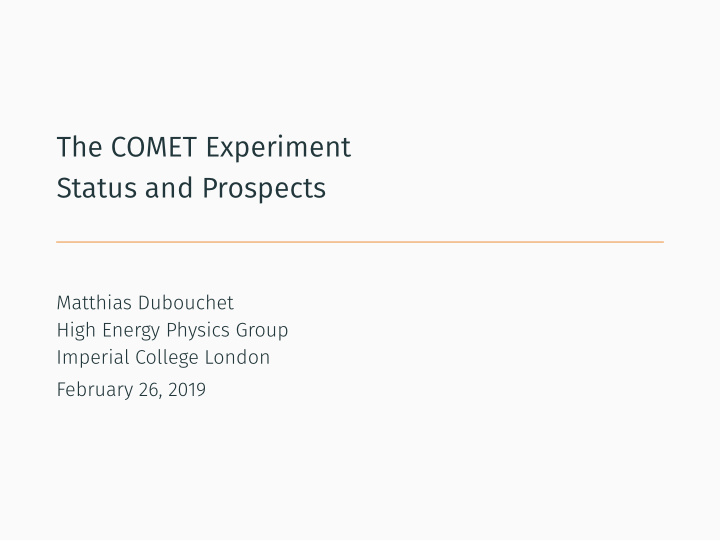



The COMET Experiment Status and Prospects Matthias Dubouchet High Energy Physics Group Imperial College London February 26, 2019
The COMET experiment COMET Dubouchet M. 2 Source: Google Source: AAPPS
The COMET experiment COMET Dubouchet M. 3 Source: Google Source: AAPPS
Muon-to-electron conversion Muon-to-electron conversion: • Individual lepton fmavours are not conserved, which contradicts Standard Model. background. • Observing a single event would be evidence of more BSM physics. COMET Dubouchet M. 4 µ − + N ( A , Z ) → e − + N ( A , Z ) • Mono-energetic electron → very clean signal, very low
COMET: objectives COMET Dubouchet M. 5 • Measure, or set a limit on, the rate of µ – e conversion: µ − + N ( A , Z ) → e − + N ( A , Z ) . • End goal: improve current limit on µ – e conversion by a factor of at least 10 4 compared to current limit.
COMET: full layout COMET Dubouchet M. 6 Source: COMET TDR
Timeline Key dates: • May 2019 : beam campaign with Phase-I Cylindrical Drift Chamber at Kyoto University’s Reactor Research Centre. • Late 2019 : Phase-I is being brought online, through calibration and cosmic background measurements. • Early 2020 : proton beam from Main Ring is delivered. Beam diagnostics, more calibration, followed by fjrst data-taking and analysis. After 150 days of data-taking, expect sensitivity increase by a factor of 100. • Mid-2020s : Phase-II deployed and running, expected to yield another factor 100 or more on the sensitivity. COMET Dubouchet M. 7
State-of-the-art studies at Imperial Ewen Gillies: Cylindrical Drift Chamber Hit Filter Combine Hough transform with Gradient Boosted Decision Tree classifjer to automate track identifjcation. Allows us to push the intensity by fjltering out undesired hits. COMET Dubouchet M. 8 Source: Ewen’s thesis
State-of-the-art studies at Imperial Siyuan Yan: Optimising the stopping target geometry Generate new geometries and use genetic algorithms to automatically select the best one. Optimisation problem between the number of muons captured by the aluminium target and the total target mass. COMET Dubouchet M. 9
The next step Ideas for future research: • Picking up on Ewen’s work: can we use the third dimension to improve classifjcation? • Can we parallelise the classifjcation process and use FPGAs for online hit fjltering? • High level analysis framework needs to be chosen and implemented this year. • Can we use modern machine learning, e.g. (convolutional) neural networks, for track identifjcation and other purposes? COMET Dubouchet M. 10
Conclusion There are still many ways in which COMET can be pushed to achieve the best sensitivity. With Ewen leading the way with his machine learning application, many more possibilities are now open. COMET Dubouchet M. 11
Conclusion There are still many ways in which COMET can be pushed to achieve the best sensitivity. With Ewen leading the way with his machine learning application, many more possibilities are now open. Thank you! COMET Dubouchet M. 12
State-of-the-art studies at Imperial Hit fjlter performance evaluation COMET Dubouchet M. 13 Source: Ewen’s thesis
Recommend
More recommend